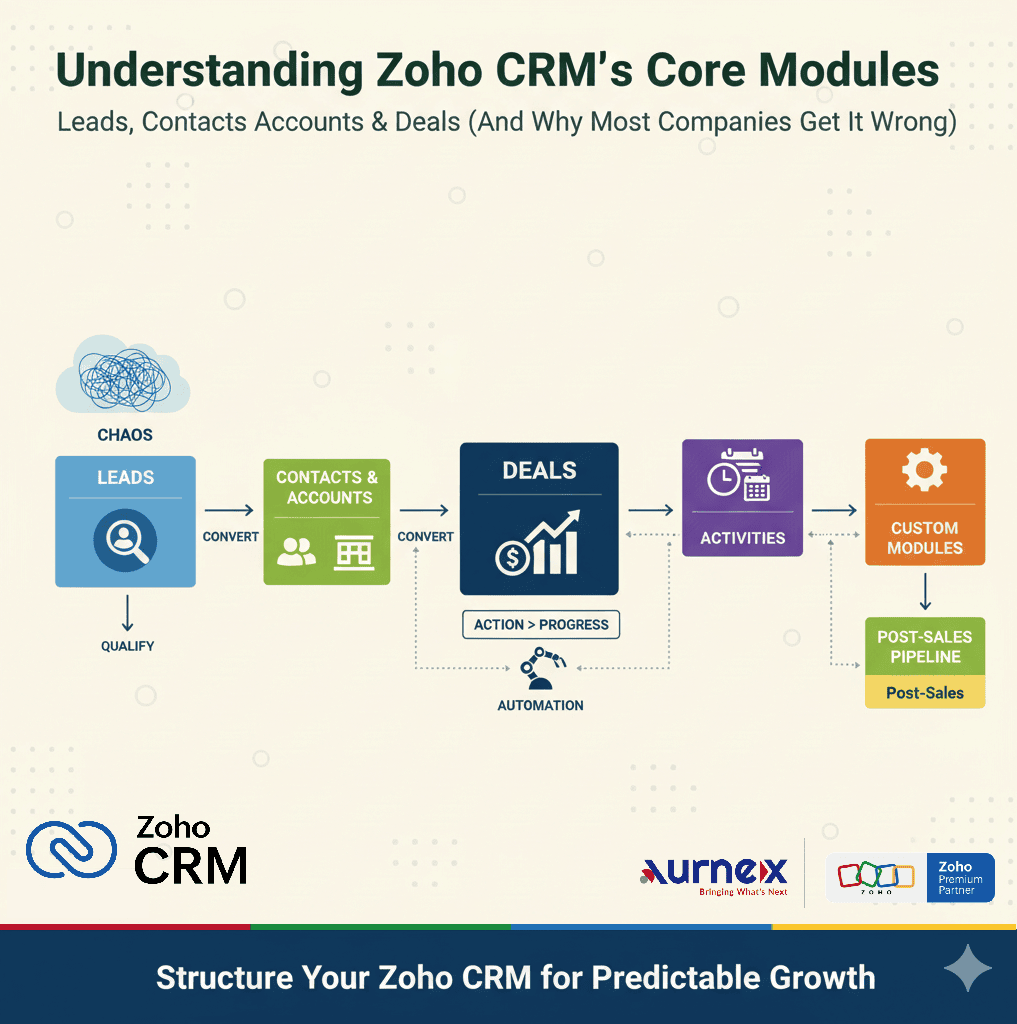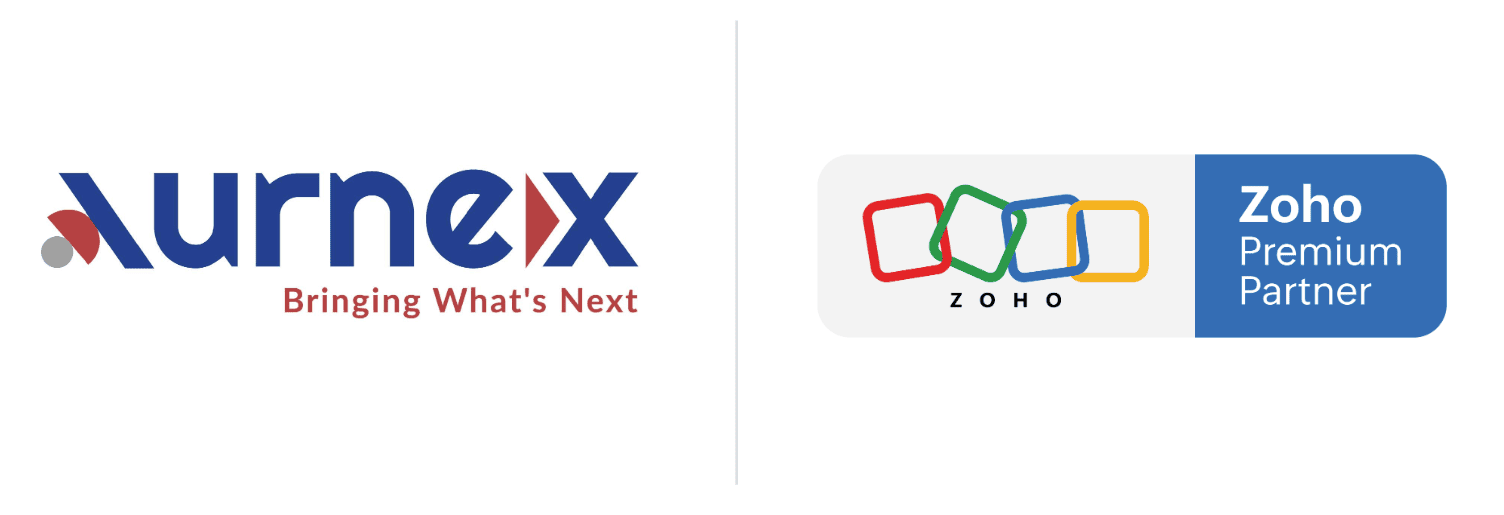
If you’ve recently started exploring Zoho CRM, there’s a good chance you’ve stared at the modules — Leads, Contacts, Accounts, Deals, Activities — and wondered, “What goes where? What do we convert? What pipeline should we follow?”
This guide breaks down the core CRM modules in simple terms, backed by what we’ve learned over years of implementing Zoho CRM across B2B, B2C, and high-growth companies.
Let’s start at the beginning.
✅ 1. Leads: Your “unqualified” world — not customers, not deals
Most companies make the mistake of treating every inquiry as a Deal or potential sale from day one.
This creates chaos.
In Zoho CRM, a Lead simply means:
You don’t know them yet
You don’t trust them yet
They haven’t shown buying intent yet
You haven’t validated fit yet
A lead could be:
A website form submission
An inbound call
A WhatsApp inquiry
A referral
An event contact
A downloaded brochure
A signup
✅ Your job in the “Lead module” is not to sell
Your job is to qualify:
Are they a fit?
Do they have real interest?
What problem are they trying to solve?
What’s their timeline and budget?
Are they worth progressing?
This is where nurturing and basic activities (calls, emails, follow-ups) happen.
If they’re not a fit → you close the lead.
If they are → you convert.
✅ 2. When do you convert a Lead to a Contact, Account & Deal?
Think of conversion as a checkpoint.
You convert when:
✅ They have a real requirement
✅ You understand what they want
✅ They are willing to have a deeper sales conversation
✅ You’ve qualified the need clearly
✅ The opportunity is real
When you hit these points, you convert the lead.
Zoho CRM automatically creates:
Contact (the person)
Account (the company)
Deal (the revenue opportunity)
This is one of the most important habits of good CRM design.
It keeps your system clean, predictable, and scalable.
✅ 3. Deals: The actual revenue journey
If Leads are about qualification, Deals are about movement.
A Deal represents:
A real potential sale
With defined next steps
With a structured process
With a trackable value
With a predictable timeline
This is where your pipeline stages matter.
✅ What your Deal Pipeline MUST include
Your pipeline should be action-based, not feeling-based.
❌ Stages like “Interested”, “Hot”, “Warm”, “Follow-up”
✅ Stages like:
Discovery Call Completed
Requirements Collected
Proposal Shared
Proposal Reviewed
Negotiation
Final Decision Pending
Closed Won / Closed Lost
Action → progress.
Progress → forecasting.
Forecasting → predictable revenue.
✅ 4. Activities: The oxygen of your CRM
Nothing moves in a CRM unless a human (or automation) moves it.
That’s why activities — Calls, Meetings, Tasks — matter more than anything else.
✅ Calls
- Zoho CRM Mobile automatically logs calls, call duration, and follow-up tasks.
- Integrations with third-party calling tools also sync recording, statuses, and outgoing calls.
✅ Meetings
Using the Zoho CRM mobile app, your sales team can:
Check in at meeting location
Capture geolocation
Record notes
Log next steps
Add voice notes
Upload documents
Perfect for field sales teams, distributors, channel partners, real estate, and service industries.
✅ Tasks
Tasks ensure nothing slips through cracks:
Send proposal
Follow up after demo
Confirm decision call
Collect documents
Review pricing
Activities give visibility, accountability, and discipline.
✅ 5. When your deal closes — the pipeline doesn’t have to end
Many businesses think their job is done when a deal becomes Closed Won.
But the real work begins after that:
onboarding
project setup
service delivery
installation
training
documentation
approvals
collection
renewal
That’s why smart companies create a second pipeline — an operations pipeline.
✅ Sales Pipeline = Selling
✅ Operations Pipeline = Delivering
This keeps the entire lifecycle in one CRM, not across WhatsApp groups, emails, or separate tools.
✅ 6. Custom Modules: When your business outgrows defaults
Every business is unique.
That’s why Zoho CRM lets you create custom modules:
Bookings
Installations
Applications
Tickets
Site Visits
Subscriptions
Compliance
Approvals
These modules become part of your end-to-end CRM → Ops → Delivery → Support process.
And when designed well, they eliminate miscommunication between teams.
✅ 7. Automation: Keep your CRM working even when your team is busy
Most businesses under-use automation in Zoho CRM.
Your CRM should:
✅ Assign leads automatically
✅ Send WhatsApp/SMS/email notifications
✅ Trigger follow-up tasks
✅ Track inactive deals
✅ Remind sales reps of meetings
✅ Alert managers about high-value opportunities
✅ Nurture cold leads automatically
✅ Sync with Website, Books, Desk, Projects
A CRM where humans must remember everything → will always fail. Automation fills these gaps.
✅ 8. Real Example: B2B (Manufacturing)
A manufacturer receiving 150+ monthly inquiries tried to manage everything with one big Deal pipeline.
‼️ No Leads module.
‼️ No conversions.
‼️ No structure.
❌ ☠️ Their pipeline was a graveyard. ❌
After restructuring:
✅ Leads → qualification
✅ Convert only when real requirement exists
✅ Clean Deal stages
✅ Activities enforced through Blueprint
✅ Post-sales pipeline for delivery
✅ Mobile check-ins for on-the-spot visits
✅ Manager alerts for high-value enquiries
In 3 months, their follow-up time dropped by 60% and reporting became reliable.
✅ 9. Real Example: B2C (Real Estate Sales)
A real estate firm used Deals for every inbound inquiry.
Even casual website visitors were added as “Deals”.
After redesign:
✅ Leads captured through website + WhatsApp
✅ Qualification → conversion
✅ Deals represent only actual site visit–ready buyers
✅ Meeting check-ins used for tracking
✅ Tasks auto-created for document uploads
✅ Automations send instant WhatsApp confirmations
✅ Post-sales pipeline tracks handover process
Their sales team stopped chasing noise and started chasing buyers.
✅ 10. Final Thought — CRM is structure, not software
Zoho CRM works beautifully when the modules are used as intended:
Leads → qualification
Contacts & Accounts → Real People & Companies
Deals → Real revenue
Pipelines → Actions
Activities → Movement
Mobile → Real-time truth
Custom modules → Your Operations
Automation → Consistency
Post-sales pipeline → Complete lifecycle
Most CRM confusion disappears when structure appears. Businesses that follow this framework see:
✅ Cleaner data
✅ Faster follow-ups
✅ Predictable forecasting
✅ Better team accountability
✅ A CRM that the team actually likes using
This is the difference between “using Zoho CRM” and “using Zoho CRM effectively.”
Ready to Structure Your Zoho CRM the Right Way?
If you’re exploring Zoho CRM or looking to fix an existing setup, the best investment you can make is getting the foundation right.
Clear modules, clean pipelines, consistent activities, and simple automations can transform how your sales and operations work every single day.
If you’d like an expert review of your current CRM structure — or guidance on how to design it the right way from Day 1 — you can schedule a quick consultation with our team.
No sales pitch, no obligation.
Just a practical conversation to help you understand what your CRM needs next.
👉 Book a free 30-minute Zoho CRM consultation below.
Build your CRM with clarity now, and it will support your growth for years.



